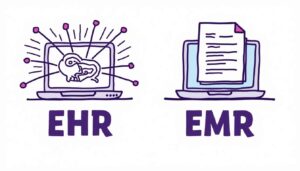How to Effectively Utilize Virtual Medical Assistant in Healthcare
27 Aug 2025 By: Vlade Legaspi
Updated

Healthcare has changed fast as technology now plays a key role in daily medical tasks. One strong tool is the virtual medical assistant, which helps doctors work faster. It cuts down admin work and helps provide better care.
Many systems now utilize virtual medical assistant tools to meet growing patient needs and rising costs. VMAs ease the load and boost overall efficiency in care delivery.
The following guide provides instructions for proper virtual medical assistant tool utilization. The guide provides information about their advantages and practical applications as well as installation procedures and upcoming developments. The knowledge of VMAs allows all staff members from administrative personnel to medical professionals and technology enthusiasts to manage the rapid changes in modern healthcare.
Understanding Virtual Medical Assistants: What They Are and How They Work

Defining Virtual Medical Assistants
Virtual Medical Assistants are AI tools built to help doctors and patients by automating simple tasks and improving communication. They work through chat, voice, or EHR systems instead of in person.
These tools use NLP, machine learning, and data to handle patient questions, set appointments, find records, and support decisions. Many now utilize virtual medical assistant tech to boost access and speed. VMAs also help patients take more control of their care.
Core Functionalities of VMAs
Virtual Medical Assistants typically offer a range of functionalities, including but not limited to:
- Appointment Scheduling and Reminders: Automating patient bookings and sending timely notifications to reduce no-shows.
- Patient Triage and Symptom Checking: Guiding patients through symptom assessment to determine urgency and recommend next steps.
- Medication Management: Reminding patients about medication schedules and potential interactions.
- Clinical Documentation Support: Assisting clinicians by transcribing notes and populating EHR fields.
- Patient Education: Providing tailored health information and answering common questions.
VMAs also support telehealth visits, letting patients speak with doctors from home. This helps people in remote areas or with limited movement get fast care.
Many healthcare groups now utilize virtual medical assistant tools to study patient data and spot trends. These insights help improve care and boost outcomes.
Statistics Highlighting VMA Adoption
A 2023 Deloitte report shows over 40% of U.S. healthcare groups now use virtual assistants in daily tasks. Accenture found 75% of patients are open to AI tools for routine care.
As more groups utilize virtual medical assistant tools, the market is set to hit $2.8 billion by 2027, growing over 20% yearly. These tools now offer tailored care by using patient data.
This tech shift boosts efficiency and deepens patient trust. VMAs help create a care model focused on each person’s needs and history, improving overall care quality.
Benefits of Utilizing Virtual Medical Assistants in Healthcare

Enhancing Operational Efficiency
One key benefit of VMAs is cutting down admin work. Doctors often lose time on tasks like scheduling, billing, and follow-ups. VMAs handle these fast and well.
The Cleveland Clinic saw a 30% drop in admin tasks after using VMAs for managing appointments and messages. Staff felt less stress and worked better.
More providers now utilize virtual medical assistant tools to send reminders and follow-ups. This keeps patients on track and boosts care quality and workflow.
Improving Patient Engagement and Satisfaction
Virtual Medical Assistants give patients fast, easy access to care info and services. They answer health questions, send med reminders, and book appointments fast.
This helps people in remote or underserved areas get care without delays. Many now utilize virtual medical assistant tools for quick, personal support.
A Journal of Medical Internet Research study showed higher patient satisfaction with VMAs. These tools also teach health tips based on each person’s needs.
Supporting Clinical Decision-Making
Advanced VMAs help doctors by reviewing patient data and suggesting care options. They don’t replace doctors but guide them with alerts and useful insights.
Mayo Clinic uses AI tools to check histories and lab results, making diagnoses faster and more accurate. Many providers now utilize virtual medical assistant tech.
VMAs give real-time insights and spot trends in health data. This helps doctors act early, improve care, and work better as a team to treat patients well.
Reducing Healthcare Costs
VMAs help cut hospital visits and readmissions by handling routine tasks and guiding patient care. This eases strain and lowers costs for healthcare systems.
A McKinsey report says the U.S. could save $150 billion yearly by 2026 if more providers utilize virtual medical assistant tools to boost efficiency and cut errors.
Less admin work lets systems focus funds on direct care. As VMAs grow smarter, they’ll help manage costs and improve care, driving long-term healthcare change.
Practical Applications of Virtual Medical Assistants in Healthcare Settings

Virtual Assistants in Primary Care
Primary care practices gain from VMAs by handling intake, checking symptoms, and managing follow-ups. They gather histories, helping doctors prep and save time.
The Veterans Health Administration uses VMAs for triage and questions, boosting access for millions. Many now utilize virtual medical assistant tools for faster support.
VMAs also track patient trends and data, helping clinics plan better care. This leads to smarter community health steps and stronger care systems.
Chronic Disease Management
Patients with chronic issues like diabetes or asthma need steady care. VMAs help by sending daily reminders, tracking symptoms, and warning doctors when needed.
Programs that utilize virtual medical assistant tools for diabetes have improved blood sugar control, as shown in a 2022 Diabetes Technology & Therapeutics study.
VMAs also support telehealth visits, helping patients share updates from home. This builds trust and keeps patients more engaged in managing their health.
Mental Health Support
Mental health care often struggles with long waits and stigma. VMAs help by offering early screening, coping tips, and links to care or emergency help.
Apps like Woebot and Wysa utilize virtual medical assistant tech to deliver CBT tools. They track mood and give mental health teams useful insights.
Adding VMAs to mental health services ensures faster support. This can prevent crises and boost long-term well-being for people needing ongoing care.
Hospital and Emergency Department Integration
In hospitals, VMAs help with check-ins, discharge steps, and meds review. ERs utilize virtual medical assistant tools to collect info and speed up triage.
Mount Sinai saw better patient flow and less crowding after adding VMAs to their ER process. These tools also give real-time updates to patients and families.
This reduces stress and boosts patient experience. As care systems grow, more will utilize virtual medical assistant tech to improve service and save time.
Implementing Virtual Medical Assistants: Best Practices and Considerations

Assessing Organizational Needs and Goals
Successful use starts with knowing your goals and challenges. Whether easing admin tasks or boosting care, you must set clear aims to utilize virtual medical assistant tools well.
Clinicians, staff, and IT teams should join the planning to shape the right fit. Surveys and focus groups help spot pain points and match tools to real needs.
Ensuring Data Privacy and Security
Healthcare data is sensitive, so following HIPAA rules is a must. To utilize virtual medical assistant tools safely, systems need strong security and encryption.
Use secure storage, limit access, and add multi-factor login. Train staff often and stay updated on threats. Work with trusted vendors who run regular audits.
Integrating with Existing Systems
To utilize virtual medical assistant tools well, they must link smoothly with EHRs, management systems, and messaging tools for real-time updates and less work.
Choose solutions that scale as tech grows and patient needs rise. Work with IT and vendors to shape a good fit. Test often and fix issues early to avoid care delays.
Training Staff and Educating Patients
To utilize virtual medical assistant tools fully, staff must learn how they work and where limits lie. Training should cover hands-on use, videos, and clear guides.
Patients also need help using VMAs. Teach them about safety, privacy, and ease of use. Set up help desks or forums for support and shared feedback.
Monitoring Performance and Continuous Improvement
To utilize virtual medical assistant tools well, track results like patient satisfaction, task success, and fewer errors. Set clear KPIs to measure and guide progress.
Use feedback from staff and patients to improve the VMA. Update content and features to match changing needs. Keep refining to boost care and user trust.
Challenges and Limitations of Virtual Medical Assistants

Accuracy and Reliability Concerns
Though useful, VMAs can misread input or miss key info. It’s vital to utilize virtual medical assistant tools as support, not as replacements for doctors.
VMA accuracy depends on the quality of training data. Bias or gaps can affect care for some groups. Keep systems updated to follow the best medical standards.
Patient Trust and Acceptance
Some patients fear using AI tools due to privacy or lack of human touch. To build trust, be clear about how you utilize virtual medical assistant systems.
Explain what VMAs can and can’t do. Show they help with simple tasks but don’t replace doctors. This builds confidence and supports better patient care.
Technical Barriers and Accessibility
Not all patients can easily access or use tech. To utilize virtual medical assistant tools well, offer them on phones, browsers, and voice platforms.
Keep the design simple and clear. Teach patients how to use the tools through training or workshops. Add language support to reach more users and close gaps.
The Future of Virtual Medical Assistants in Healthcare

Advancements in AI and Natural Language Processing
Ongoing improvements in AI algorithms and NLP will enable VMAs to understand context better, engage in more natural conversations, and provide increasingly personalized care recommendations. This evolution will enhance their utility across diverse clinical scenarios.
Integration with Wearables and Remote Monitoring
The convergence of VMAs with wearable health devices and remote patient monitoring systems promises a new era of proactive and preventive care. Virtual assistants could analyze real-time data to detect early warning signs and prompt timely interventions.
Expanding Roles in Population Health Management
As healthcare shifts toward value-based care, VMAs will play a pivotal role in managing population health by identifying at-risk patients, coordinating care plans, and facilitating communication across care teams.
Ethical and Regulatory Evolution
The growing use of AI in healthcare will necessitate updated ethical guidelines and regulatory frameworks to ensure patient safety, fairness, and accountability. Stakeholders must collaborate to establish standards that balance innovation with responsibility.
Trending Now!
Green Mountain Partners for Health in Denver faced staff shortages and high costs, with just one medical assistant on site. To ease pressure, they hired virtual assistants (VAs) to handle admin tasks like faxes, messages, billing, and prior authorizations. This helped raise pay and morale for in-person staff, lower stress, and boost patient care. Dr. Carolynn Francavilla shared this success through an AMA session, showing how VAs can raise efficiency without losing quality.
Starting with two VAs, the clinic added more as benefits grew clear. VAs handled triage, chronic care, and remote patient monitoring, freeing staff for direct care. Dr. Francavilla stressed the need for proper training and HIPAA compliance. The results: smoother billing, better service, and higher staff satisfaction—proving VAs are a smart solution in today’s tight healthcare market.
Conclusion
Virtual Medical Assistants mark a big step forward in healthcare tech. They boost efficiency, improve care, and support clinical choices when used the right way.
To utilize virtual medical assistant tools well, address privacy, accuracy, and access. Adopting VMAs helps providers give better care in a digital world.
Ready to see the benefits of Virtual Medical Assistants in action? Join HelpSquad Health and explore how our tools can improve care and save time. Try our free trial today and start making healthcare simpler.


